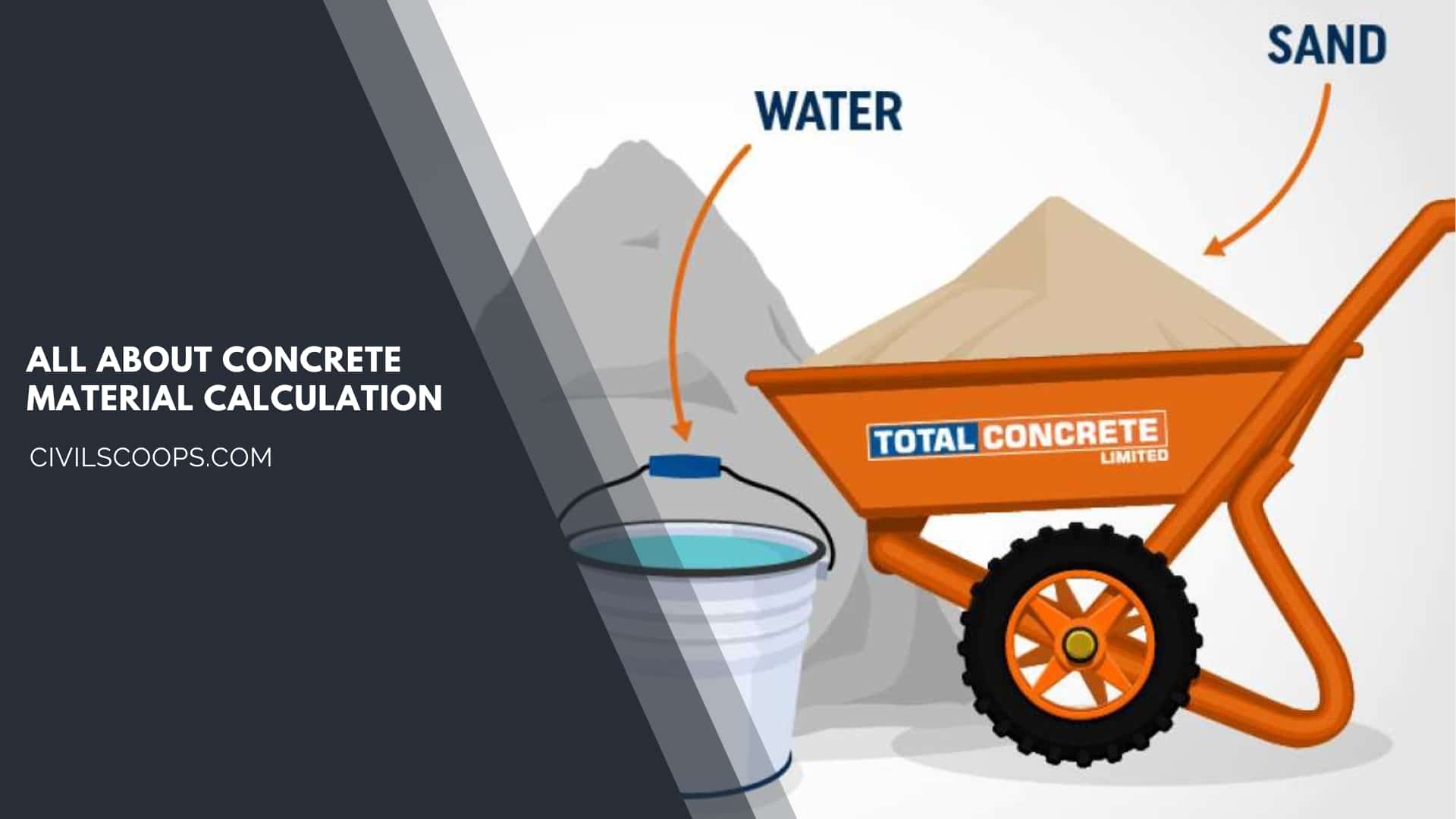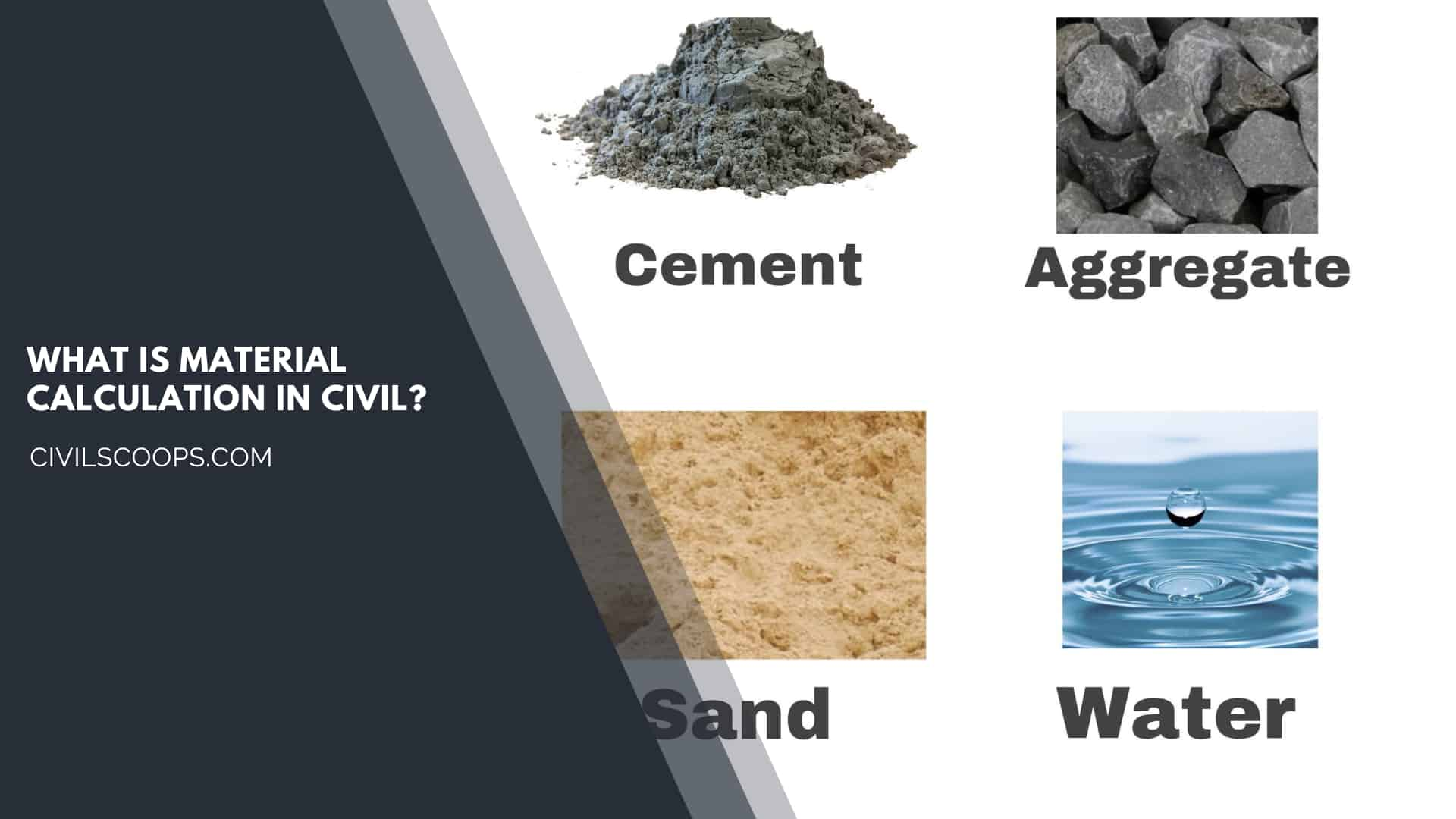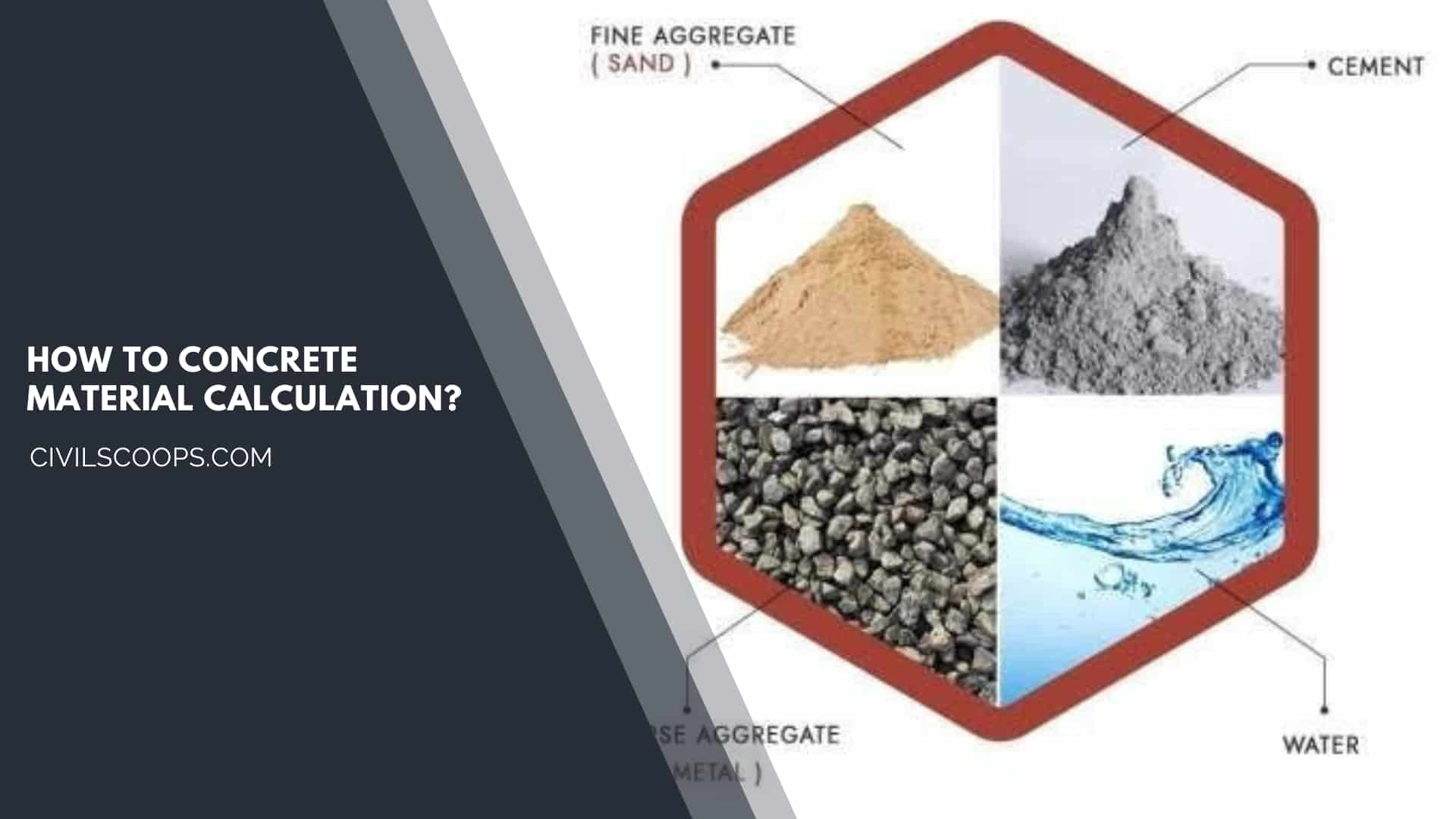Concrete Material Calculation / Concrete Quantity

Table of Contents
What is Material Calculation In Civil?

In civil material calculation, especially when it comes to concrete material calculation, it involves determining the required quantities for various tasks such as Concrete, Bar Bending, Plumbing, Flooring, and Electrical.
Material Use in Concrete
When considering the materials for concrete, it’s composed of different parts of one product. All materials, namely Cement, Sand, Aggregate, Water, and Addmixuer, form a part of concrete.
Concrete is defined as a different grade like M15, M20, M25, as per IS Code 456. All concrete Grade different mix designs. All mix design different materials, different positions.
All different material types of measurement units like Water measurement in liter and Cement in Bag, Aggregate in k.g. But Concrete is a measurement in Cubic Meter.
Also Read: All About Green Concrete | What Is Environmentally Friendly Concrete
How to Concrete Material Calculation?

For concrete quantity calculation, especially for specific grades like M 15 concrete, the first step is to determine the proportions of material. For instance, M 15 ratio is 1 : 2 : 4, while M20 is 1 : 1.5 : 3, and so on. Above M 25 Grade concrete requires a mix design.
Here 1 : 2 : 4 is Material how to define which material first number 1 is a Cement, Secon number material is a Fine Aggregate (Sand), here the third number is Coarse Aggregate, as per the sequence of proportions.
This method is based on a principle that the volume of fully compacted concrete is equal to an absolute volume of all the materials of concrete, i.e., cement, sand, coarse aggregates, and water.
This concrete structure may consist of footing, slabs, columns, beams, and foundations, etc. based on the types of structure.
A volume of concrete required for concrete structure may be calculated by summing up to the volumes of each structural member or each part of members.
The volume of a rectangular cross-sectional member may be calculated as Length x Width x Height/Depth/Thickness. The suitable formula shall be used for different cross-sectional shapes of members.
The formula for concrete material calculation for the required volume is given by:
Vc =Volume of Concrete
Vce = Volume of Cement
Vf = Volume of Fine Aggregate
Vca = Volume of Coarse Aggregate
Vw = Volume of Water
Sc = Specific Gravity of Concrete
Sce = Specific Gravity of Cement
Sf = Specific Gravity of Fine Aggregate
Sca = Specific Gravity of Coarse Aggregate
ce= Cement
f = Fine Aggregate
ca = Coarse Aggregate
dr = Dry Volume
we = Wet Volume
sa =Sum propositions Ratio
Above all Short Form Use in Equation
Also Read: What Is Bulkage of Sand (Fine Aggregate )
Useful Article for You
- How Much Does Hempcrete Cost
- How to Build a Lean to Roof
- How Dense Is Sand
- How to Make Mortar from Scratch
- How Tall Is a Kitchen Counter
- How to Use a Hand Sight Level
- How to Resurface Concrete
- How to Layout a Building
- How Is the Skeleton Similar to the Frame of a House
- How to Seal a Brick Wall
- How to Use Portland Cement
- How to Form a Monolithic Slab
- How to Get Rid of Gloss Paint Fumes
- How Are Bridge Foundations Built
- How to Calculate Fineness Modulus
- How to Measure Slump in Concrete
- How Does a Cantilever Bridge Work
- How Much Is Flagstone Per Square Foot
- How Is the Skeleton Similar to the Frame of a House
- How Long Is a Standard Parking Space
- How Much Are Coffered Ceilings
- How Much to Pump a Septic
- How Tall Are Standard Door Frames
- How to Construction
- How Are Tunnels Built
- How Do Shear Walls Work
- How to Use a Washer and Screw
- How Wide Is a Cinderblock
- How to Fix Spalling Concrete Foundation
- How Does a Beam Bridge Work
Lest Go Find Materials of Cement in Concrete
First Grade of Concrete
So We Going M-15 Grade of Concrete.
M-15 Concrete Propositions ratio 1:2:4 (ce:f:ca)
Here, 1 is a Cement, 2 is a Fine Aggregate, 4 is a Course Aggregate.
Dry Volume of concrete = Wet Volume of Concrete X 55 % (Because of working time Dry Volume less as per using qty so, we need 30% and 25 % of wastage qty, Here 30% + 25% = 55% access of this qty)
Sum propositions Ratio (sa) = 1+2+4 = 8
Vce = Volume of Cement / Cement Volume
Vce = dr x (ce/sa) Cu.m.
Vce = 1.55 x (1/8) Cu.m.
Vce = 1.55 x 0.125 Cu.m.
Vce = 0.19375 Cu.m.
How to Converter Cement Qty in Cu.m. to Bag?
The volume of Cement Cu.m. = 0.034722 x Cu.m. qty (0.0347222 is Volume of qty for one bag)
How to find 0.034722 = 50/1440 (Each Cement Bag Weight = 50 kg, Density of Cement / Cement Volume = 1440 kg/ Cu.Meter., Volume of Cement Bag in Cubic Feet = 35.3147 )
Vce in bag = 0.19375 x (1/0.034722)
Vce in bag = 5.58 bag
or
Vce in kg = 0.19375 x 1440 (1440 kg/Cu.m is a cement density)
Vce in kg =279 kg Cement
Vce in bag = 279kg /50kg (1 bag = 50 kg) = 5.58 Bag
Vf = Volume of Fine Aggregate/Sand
Vf = dr x (f/sa) Cu.m.
Vf = 1.55 x ( 2/8) Cu.m.
Vf = 1.55 x 0.25 Cu.m.
Vf = 0.3875 Cu.m. This qty of fin aggregate in Cu.m.
How to Find Fine Aggregate in Cu.m. to Kg?
Sf = Specific Gravity of Fine Aggregate = 1700 kg/ Cu.m.
Vf in kg = 0.3875 Cu.m. x 1700 kg/ cu.m.
Vf in kg = 658.75 kg
Vca = Volume of Coarse Aggregate
Vca = dr x (ca/sa) Cu.m.
Vca = 1.55 x (3/8) Cu.m.
Vca = 1.55 x 0.375 Cu.m.
Vca = 0.58125 Cu.m. This qty of Coarse Aggregate in Cu.m.
How to Find Coarse Aggregate in Cu.m. to Kg?
Sca = Specific Gravity of Coarse Aggregate = 1650 kg/ Cu.m.
Vca = 0.58125 Cu.m. x 1650 kg/ Cu.m.
Vca in kg= 959.06 kg.
Vw = Volume of Water
w/c = 0.45 as per IS Code 456:2000 Table-5
Required water for 1 cement bag= 0.45 × 0.034722 = 0.015625 cum
1 Cu.m. water = 1000 litr.
Required water for 1 cement bag=0.015625 × 1000 = 15.63Litre.
Vw for 1 Cu.m. Concrete in Water = 15.63 litr x 5.58 bag = 87.22 litr
Vw = 87.22 litr
Summary of Using the concrete material calculator, the Concrete Material Calculation is as follows:
Vce in bag = 5.58 bag (Cement in Bag)
Vf = 658.75 kg (Fine Aggregate in kg)
Vca = 959.06 kg. (Coarse Aggregate in kg)
Vw = 87.22 liters (Water in Liter)
[su_box title=”FAQ” style=”default” box_color=”#333333″ title_color=”#FFFFFF” radius=”3″ class=”” id=””]
Concrete Material Calculation
Calculating the volume for concrete requires using three dimensions: length times width (which is area) times the height (thickness) or L x W x H. If you are using feet as your standard unit of measurement, this formula will give you the volume of concrete in cubic feet.
Concrete Mix Calculator
A concrete mix calculator is a tool or method used to determine the quantity of various materials, such as cement, sand, and aggregate, needed to produce a specific volume of concrete for a construction project. It takes into account factors like the dimensions of the area where the concrete will be poured, as well as the desired thickness or depth of the concrete. This calculation helps ensure that the right amount of materials is ordered, minimizing waste and ensuring the project is completed accurately and efficiently.
Concrete Material Calculation Formula
Calculation Of Materials For Different Mix Ratio
- Volume of dry concrete = 1 × 1.54 = 1.54 m3.
- Formula, Cement = (Volume of dry concrete/a+b+c) × a.
- Formula, Sand = (Volume of dry concrete/a+b+c) × b.
- Formula, Aggregates = (Volume of dry concrete/a+b+c) × c.
- Required water for 1 bag of cement=0.0159 × 1000 = 15.9 Litre.
How Many Yards of Concrete Do I Need for a 24x24x4 Slab?
For a 24x24x4 slab, you will need exactly 7.11 cubic yards of concrete. Considering the slab of 24 feet x 24 feet x 4 inches, the required concrete yards or volume = area x thickness, as explained in this article.
How Many Bags of Cement to Make 1m3 of Concrete 1 2 4?
Typically, a standard bag of cement in India covers approximately 0.035 cubic meters (35 liters) of volume. Rounded to the nearest whole number, approximately 4 cement bags would be needed for 1 cubic meter of concrete with a 1:2:4 mix ratio.
Concrete Materials Examples
The principal ingredients that make up the concrete mix are: cement, fine aggregate, coarse aggregate, water, chemical admixtures, and mineral admixtures. Concrete used in construction may also contain reinforcing bars, welded wire fabric (wire mesh), and various reinforcing fibers.
Ready Mix Concrete Calculator
You will want to:
- Determine how thick you want the concrete.
- Measure the length and width that you’d like to cover.
- Multiply the length by the width to determine square footage.
- Convert the thickness from inches to feet.
- Multiply the thickness in feet by the square footage to determine cubic feet.
How to Calculate Concrete Material?
Rectangular Concrete Formula
Length in feet multiplied by width in feet multiplied by height in feet divided by 27 equals cubic yards needed.
How to Calculate Concrete Quantity?
Just follow these steps:
- Measure the area in feet.
- Multiply length by width, and then by thickness.
- Divide the resulting number by 27 to find cubic yards.
[/su_box]
[su_note note_color=”#F2F2F2 ” text_color=”#333333″ radius=”3″ class=”” id=””]
Like this post? Share it with your friends!
Suggested Read –
- What Is Moment Frame
- What Is Concrete Forms
- What Is a Flight of Stairs
- All About Turbidity of Water
- New Civil Engineering Technology 2023
[/su_note]
Originally posted 2023-10-03 12:00:22.
